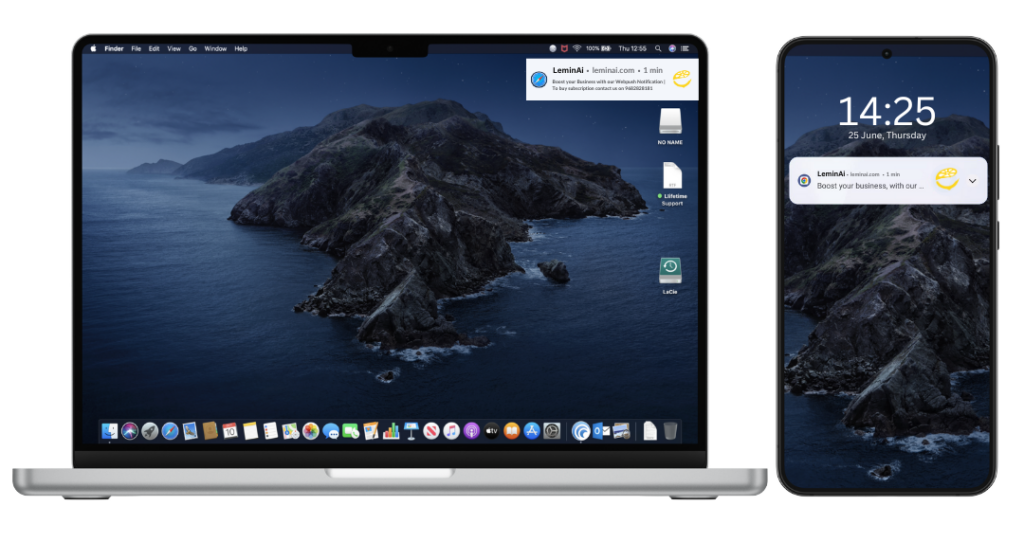
Introduction to Web Push Notification
In today’s digital world, businesses and marketers are constantly looking for ways to engage users and drive better conversion rates. One powerful tool that has gained significant traction is the web push notifications. This form of communication allows websites to send instant messages directly to users’ desktops or mobile devices, even when they are not actively browsing your website.
In this blog, we’ll explore what web push notifications are, how they work, the different types (such as bulk web push notifications and segmented web push notifications), the benefits they offer, and how a push notification service like LeminAi can elevate your website’s engagement strategies.
What is a Web Push Notification?
A web push notification sends a message directly from a website or web application to a user’s device through the browser. Unlike traditional email campaigns or mobile app notifications, push notifications do not require app installation. Instead, they deliver via web browsers like Chrome, Firefox, Safari, or Edge.
When a user subscribes to push notifications on a website, they give the site permission to send them updates. These notifications can range from breaking news alerts to personalized offers. The key advantage of website push notifications lies in their ability to deliver real-time updates and reminders without requiring the user to be actively engaged with the website.
If you’ve ever subscribed to reminders or updates from a brand, you’re likely no stranger to the notifications that periodically pop up at the top-right corner of your desktop screen. These are web push notifications, also known as browser push notifications. They are actionable messages sent to a visitor’s device from a website through a browser.
These notifications are contextual, timely, and personalized, making them ideal for engaging users and retaining website visitors. What sets them apart from traditional website overlays or forms is that they don’t ask for personal information like your name or email address. Instead, they simply notify subscribers, helping to promote conversions and extend brand awareness without being intrusive.

As part of a modern marketing strategy, website push notifications complement traditional communication channels like Email and SMS. In fact, they often outperform these channels due to their direct, real-time nature, making them an effective tool for businesses aiming to engage and retain users efficiently.
How Does a Web Push Notification Work?
Understanding how web push notifications chrome work is crucial for leveraging their full potential. These notifications allow websites to send messages directly to a user’s browser, even when they are not actively browsing the website. Here’s a breakdown of how push notifications typically function, including how LeminAi enhances the process:
Step 1: User Opt-In
The process begins when a user visits a website and is prompted to opt-in for push notifications. To start receiving them, the user must grant permission to allow notifications from the site. This opt-in process is essential because it ensures users have control over what notifications they receive.
Step 2: Subscription
Once a user opts in, their browser generates a unique identifier for that specific device or user. This subscription process allows the website to store that ID and send web push notifications directly to the user’s browser, whether the website is open or not.
Step 3: Lifetime Connectivity
With LeminAi Web Push, even after users leave your site, you can continue sending notifications to their device. This means the connection lasts beyond their initial visit, ensuring that you can engage them later with updates, promotions, or reminders. LeminAi allows you to send unlimited push notifications to these subscribers, maintaining a long-term connection with users who may have only visited your website once.
Step 4: Seamless Delivery
One key advantage of web push notifications is their ability to reach users instantly. Whether users are on desktops, tablets, or mobile devices, LeminAi Web Push delivers notifications directly to their screen as a pop-up message. This occurs even if the website is not open, offering a significant advantage over other communication channels like email, which users may overlook or find in spam folders.
Step 5: Engagement
Once a mobile web push notification is delivered, users can interact with it, usually through clickable call-to-action buttons. For example, users might be prompted to click and return to the website, check out a special offer, or complete an action like making a purchase. This interaction boosts user engagement and drives conversions. LeminAi Web Push makes this process smooth by offering tools that encourage users to take action, improving overall user experience and helping businesses achieve their marketing goals.
Step 6: Rich Media Integration
To make notifications even more appealing, web push notifications can include rich media such as images, links, and buttons. This helps make the notifications more visually engaging and provides more context to users. Rich media can increase the likelihood of users clicking through, helping to drive traffic back to the website and improve conversion rates.
By following this process, web push notifications are an effective way to stay connected with users, even when they are not actively engaging with your website. Services like LeminAi Web Push take this functionality a step further by offering lifetime connectivity, seamless delivery, and advanced engagement features. Whether your audience is on desktop or mobile, push notifications are a powerful tool for building long-term relationships and driving business growth.
Types of Web Push Notifications
1. Bulk Web Push Notifications
Bulk web push notifications reach your entire audience with broad communication. Marketers typically use them for announcements like sales, new blog posts, or general updates. The advantage of bulk notifications is that they reach a large number of users with minimal effort, making them a great tool for businesses to keep their audience informed.
However, since bulk web push notifications chrome target everyone, they may not always be relevant to all users. This is where segmented web push notifications come into play.
2. Segmented Web Push Notifications
On the other hand, segmented web push notifications are tailored to specific groups within your audience. These notifications target users based on criteria such as location, behavior, or past interactions with the website. By segmenting your audience, you ensure that the notifications they receive are relevant to their interests, which can lead to higher engagement rates.
Segmented web push notifications drive higher click-through rates for marketers by targeting specific user groups and personalizing messages to meet their unique needs.
For instance, an e-commerce website might send a web push notification about a special discount to users who have previously purchased similar products. This personalization helps improve the user experience, making it a powerful strategy for conversion.
Benefits of Web Push Notifications
1. Instant Delivery and High Visibility
One of the main advantages of web push notifications is their instant delivery. Unlike emails, which might end up in spam folders or get overlooked, push notifications appear directly on a user’s screen. This high visibility leads to increased engagement and immediate action.
2. Increased User Retention
When used correctly, push notifications can significantly boost user retention. By sending personalized, timely updates, businesses can keep users coming back. For example, mobile web push notifications can remind users about abandoned shopping carts, enticing them to complete their purchases.
3. Higher Click-Through Rates (CTR)
Studies show that web push notifications achieve much higher click-through rates than emails. Delivered directly to the user’s device and requiring immediate action, push notifications prompt users to click, driving more traffic to your website.
4. No App Required
Another benefit of website push notifications is that they work without needing a dedicated app. Users can receive notifications even if they are not actively on your website, as long as their browser is open. This makes browser notifications an effective tool for engaging users across different devices.
5. Cost-Effective
Compared to other forms of marketing, mobile web push notifications are highly cost-effective. You don’t need to invest in developing a mobile app or pay for SMS campaigns. Plus, many free push browser notifications services allow you to send notifications without any upfront costs.
6. Expand Your Marketing Reach with Web Push Notifications
Web push notifications offer an additional marketing channel that works seamlessly with your email campaigns. Unlike emails that often get buried in busy inboxes, push notifications appear directly on users’ devices, ensuring your message stands out.
One key advantage of mobile web push notifications is that they ensure your messages are seen—even if users are not currently on your website. For example, if a user isn’t on your site when you send a push notification, they will still see it when they open their browser later. Imagine sending a web push notification of a promotional offer at 6:00 PM while a user is offline and not connected to the internet, they will still see the notification when they come online later. Let’s say they reconnect at 7:30 PM; the notification will pop up on the top-right corner of their screen, ensuring they don’t miss out.
Furthermore, push notifications reach users on all devices, including Android smartphones, tablets, and desktops, expanding your marketing reach and boosting engagement across multiple platforms.
Web Push Service Provider: LeminAi
To fully harness the power of web push notifications, businesses need a reliable service provider. LeminAi is a comprehensive push notification service that offers advanced features to help websites grow and engage their audience.
Features of LeminAi
- Easy Integration: Setup LeminAi Webpush in a jiffy with our ready integrations. Our products have zero developer intervention making it easy and smooth to get started.
- Targeted Messaging: With segmentation capabilities, LeminAi allows businesses to send personalized browser push notifications based on user behavior, location, language, device, browsers, URLs, and more.
- Analytics: LeminAi offers detailed analytics to track the performance of each campaign, ensuring that businesses can optimize their push notifications for maximum impact.
- Real-Time Delivery: Whether it’s a special offer or an urgent update, LeminAi ensures that web push notifications reach all subscribers in real time.
- Affordable Pricing: Get all these features for just ₹299/month! LeminAi Web Push provides a budget-friendly solution for businesses to engage users and boost conversions.
By using LeminAi’s free push notification service, businesses can leverage the full potential of website push notifications without any upfront costs, making it an ideal solution for both small and large enterprises.
Start Your 15-Day Free Trial Now!
Try LeminAi’s free push notification services with our 15-day FREE trial. No credit card is required—experience the full power of our push notification service before committing.
For more information on our free push notification service and LeminAi’s web notification call us at +91-9682828181.
Conclusion
In conclusion, website push notifications are a powerful tool for businesses looking to enhance user engagement and drive conversions. Whether you choose bulk web push notifications for mass updates or segmented web push notifications for personalized messaging, these notifications offer numerous benefits. They allow businesses to reach users instantly, increase retention, and drive more traffic with minimal effort.
For those looking to integrate mobile web push notifications into their marketing strategy, a reliable push notification service like LeminAi can simplify the process and ensure successful campaigns. By taking advantage of this technology, businesses can improve their communication with customers and see greater returns on their marketing efforts.


